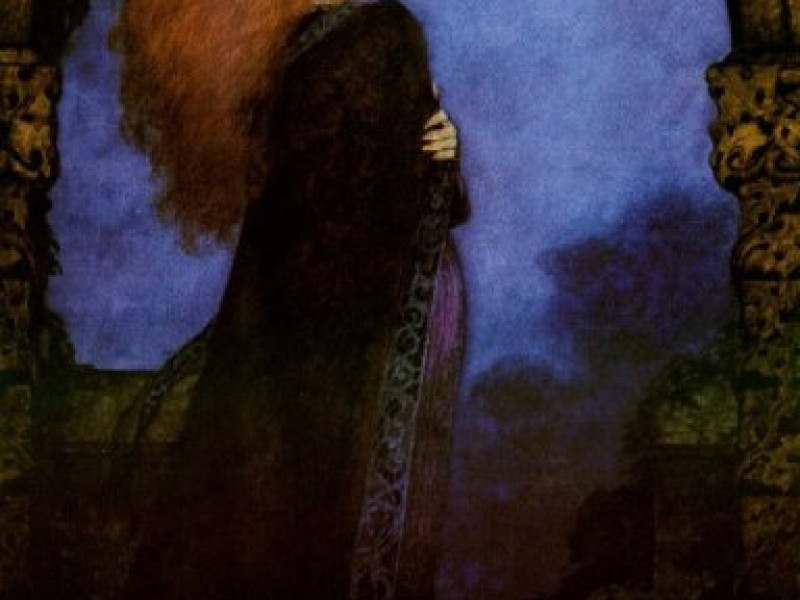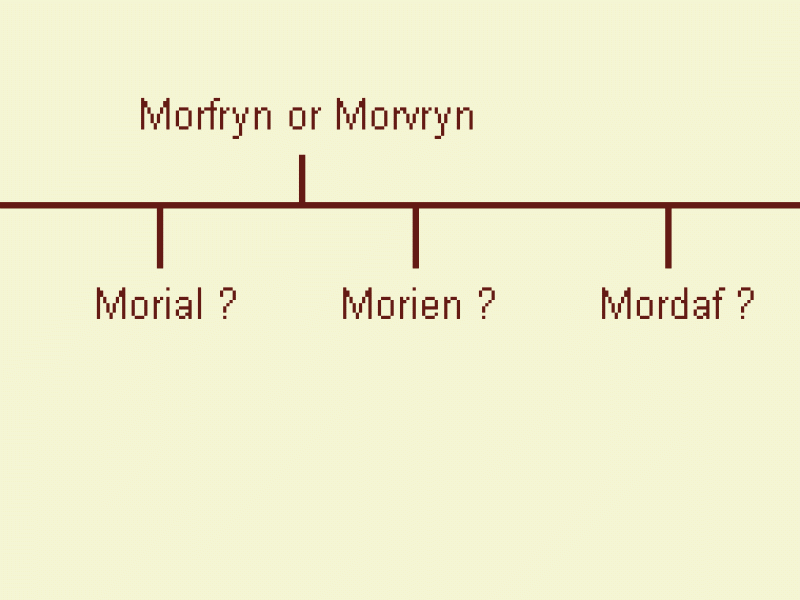Morgan le Fay
Morgan le Fay was the popular sorceress or fairy witch in the Arthurian legends.
Morgan le Fay was the daughter of King Gorlois (Hoel) of Cornwall and Igraine. Most of the time, Morgan was identified as the half-sister of Arthur. Chretien de Troyes and some other authors just referred to her as the sister of Arthur, however. By the time of the Vulgate Cycle, Morgan was Arthur's half-sister, and the sister of Morgawse and Elaine.
According to one or two writers, Morgan had a son named Mordred by her own half-brother Arthur, but most said that Mordred's mother was Arthur's other half-sister named Morgawse, Morgan's eldest sister.
It was possible that Gawain was also her son, according to L'Âtre périlleux (The Perilous Cemetary). The tale doesn't mention Morgan by name, but it was written that Gawain's mother was a fairy. Morgan was usually said to be a fairy, as she was known as Morgan le Fay. However, most texts say that Gawain's mother was Morgawse, Morgan's elder sister.
Geoffrey of Monmouth mentioned Morgan as one of the nine sisters, living in Avalon [Vita Merlini, c. 1151]. She made her first appearance here under the name Morgan. She was a healer and had the extraordinary ability to fly and transform herself to resemble anyone or anything else. Arthur was brought to Avalon by Taliesin, where the king was healed by Morgan. Here, there was no indication of any relationship between Arthur and Morgan as siblings, except that she was his healer.
Some scholars at the time said that Avalon was situated on Glastonbury, an island in the middle of marshland. Gerald of Wales (flourished in the 12th century) believed the claims by the monks of Glastonbury that Arthur was not taken there to Glastonbury/Avalon to be healed by Morgan, who was his cousin, but to be buried beside Guinevere.
In Chretien de Troyes' Erec and Enide, Morgan le Fay was a friend of Guingamar, lord of Avalon. Guingamar was one of the guests to the wedding of Erec and Enide. Later in the story, Morgan was mentioned again as a sister of Arthur and a great healer. Her name was mentioned again in Knight of the Lion, where her ointment could even heal madness from Yvain.
However, in the Welsh romance Gerient in the Mabinogion, which is basically the same story as Erec and Enide, Arthur did have a chief physician named Morgan who healed the hero, Gerient (Erec), but this Morgan Tud is clearly a man, with no blood relation to the king.
Later tales said that Morgan was the wife of King Urien and mother of the hero Owain (Yvain). However, early accounts such as by Geoffrey of Monmouth and Chretien de Troyes never said anything about Yvain (Owain) being her son, and there was also no indication in either account that Morgan was married to Urien.
According to the Vulgate Merlin, Urien married Morgan shortly after Arthur received Excalibur from the Lady of the Lake. Their son was Yvain, the hero in Chretien's romance, Knight of the Lion. This Yvain should not be confused with another son of Urien who was known as Yvain the Bastard. Also note that in Chretien's tale, there was no relation between Morgan and Yvain.
In the Welsh myth, before Geoffrey's time, Morgan was identified with the goddess Modron, the daughter of the Welsh god Avallach and the mother of Mabon. In the Welsh Triads, Modron was married to Urien, king of Rheged and mother of Owain (Yvain) and a daughter named Morfudd. In the Arthurian legends, Modron and Morgan le Fay became one and the same person because they both were married to King Urien (brother of King Lot), and both were mother of the hero Owain (Yvain). It is most likely that the name of Modron was changed into Morgan when the legend arrived in Brittany.
Morgan was also identified with another Breton goddess, Dahut or Ahes, the princess who had caused the destruction of her city Ys. Dahut/Ahes was originally a Breton sea goddess, though later accounts said that she died when the sea flooded Ys, or that she was transformed into a mermaid. However, in Brittany and elsewhere Morgan was usually a male name.
In the early legends Morgan's role was benevolent, using her power for healing. She was the fairy queen or one of the queens of Avalon. She was said to have learned her magic from Merlin. Malory says that Morgan learned magic when she was in a nunnery [Le Morte d'Arthur, Book I chapter 2].
There are similarities of Morgan with the great Irish goddess, Morrigan. Most of the time Morgan appeared as a beautiful young woman, but sometimes as an old hag like in Gawain and the Green Knight, c. 1350. Morrigan also had the same ability to shape-shift between young and old, beautiful and ugly. Like Morrigan, she was able to transform herself to look like any animal or inanimate object.
Morgan le Fay was responsible for Gawain's adventure of the beheading games with the Green Knight. Morgan gave the Green Knight the ability to survive after having had his head severed. Morgan hoped that this event would frighten Guinevere to death.
By the time of the Vulgate Cycle and Prose Tristan, her character began to change, and she became one of the mortal enemies of Arthur and Guinevere. Her role became more sinister; later writers tend to portray her as a wicked and maligned character.
Her hatred for Guinevere may have stemmed from one story when she was serving as the queen's lady-in-waiting. She was in love with a young knight who happened to be the queen's cousin. Morgan and the knight were lovers until Guinevere heard of her trysts, so the queen broke up their relationship in case they might cause a scandal. Morgan never forgave Guinevere for this incident and she sought revenge upon the queen. After this, Morgan went in search of Merlin, learning magic in exchange for offering her love to the sorcerer.
In the Vulgate Lancelot and Malory's Morte d'Arthur, she fell in love with Lancelot, whom she encountered several times. Several times she imprisoned Lancelot, refusing to release him until the hero became her lover. Each time he refused. One time, she spirited Lancelot away with two other queens who were also powerful sorceresses (in Malory's version, four queens abducted Lancelot). See Under the Apple Trees on the Lancelot page.
According to Malory, when Arthur was dying, Morgan and three other ladies, Queen of the Northgales and Queen of the Wasteland and Nimue (Niniane), arrived in a black ship. Morgan intended to take Arthur to Avalon, where she could heal her brother's wounds. The Vulgate Mort Artu only mentioned Morgan and a non-specific number of ladies on the ship.
Geoffrey and Wace mentioned that Arthur went to Avalon to be healed, but didn't mention Morgan or a ship. Layamon wrote about Arthur going onto a boat, but no Morgan. However, he did say that Argante, the fairy queen of Avalon, would heal the dying king's wounds. Layamon described Argante as a very radiant elf. Whether Morgan and Argante were one and the same person, is not very clear.
As I said before about her association with the Irish Morrigan, this suggested that she was the goddess of death or the goddess of the Underworld (ie. Avalon).
According to Breton legend, Mor means the "sea", which indicated that Morgan was a sea goddess.
Whatever her name meant or which goddesses she was identified with, Morgan was a powerful figure as the Lady of Avalon.
Related Information
Name
Morgan, Morgain.
Morgan le Fay.
Fata Morgana.
Morgana (Italian).
Modron (Welsh).
Morrigan (Irish).
By Jimmy Joe





